policy
Established in 1971, the Korea Advanced Institute of Science and Technology (KAIST) started off as a relatively modest graduate school in a few disciplines in science and technology, but has gradually expanded into a full-fledged research university over the years.
From the beginning, KAIST was intended to offer an elite science education, setting it apart from other universities in Korea. A majority of its graduates have contributed to the development of, what the world now praises, Korean industry and economy, and have led the Korean scientific community for several decades. The university has also advanced the frontiers of knowledge, conducting the lion’s share of the nation’s private research and development in basic and applied science, leading to innovations and technologies essential to the growth of today’s Korea.
As it establishes international benchmarks of success, KAIST has acquired a global reputation for delivering the highest level of science and engineering education, while performing cutting-edge research and serving as a crucial driver to generate new knowledge and innovation beneficial not only to Korea but also to the world. The university has consistently ranked in the top 100 research universities for over more than a decade, according to the world university rankings published by international ranking institutions for higher education, among others, Quacquarelli Symonds and the Times Higher Education.
KAIST will mark its 45th anniversary next year. It plans to celebrate the anniversary, and here are some of the reasons why:
KAIST’s Win at the DARPA Robotics Challenge (DRC) 2015
Team KAIST, consisted of 29 members (students and researchers) led by Professors Jun-Ho Oh of the Mechanical Engineering Department and In-So Kweon of the Electrical Engineering Department, won the international humanoid robotics competition hosted by the United States (US) Defense Advanced Research Projects Agency (DARPA). Upon completion of the first and second competitions, the finals were held on June 5-6, 2015, at the Fairplex in Pomona, California. DARPA hosted the event to spur the development of humanoid robots to assist rescue and relief efforts in dangerous environments such as the Fukushima Daiichi nuclear incident in 2011. With 24 international teams participating in the finals from the US, Japan, Germany, China, Italy, and Korea, Team KAIST’s humanoid robot, DRC-HUBO, completed all eight tasks in 44 minutes and 28 seconds, six minutes earlier than the runner-up, and almost eleven minutes earlier than the third-place team, walking away with the grand prize of USD 2 million.
< HUBO at the DARPA DRC 2015, Team KAIST >
Hitting a Grand Slam to Win Major International Design Awards
Professor Sang-Min Bae of the Industrial Design Department achieved a grand slam in international design awards with his work HEARTea, an interactive tumbler, winning four major design competitions in the world: the iF Design Award, the International Design Excellence Awards, the Red Dot Design Award, and the Good Design Award. Released in 2010, HEARTea swept prizes from the four awards which were held during the period of the year 2010-2011. The tumbler displays the temperature of liquid contained inside in three degrees (cool, warm, and hot) by showing different colored lights on the surface of the tumbler based on the liquid temperature (see picture below). In 2015, Professor Bae and his research team won three awards from the 2015 Red Dot Design Award: the Best of the Best Award and two Red Dot Design Concept Awards. The team received the Best of the Best Award, the most prestigious award among the Red Dot Design awards, for Boxchool, a modular classroom built on shipping containers, which offers underprivileged children better opportunities for learning. With greater mobility, Boxchool can be easily installed in any setting, including remote areas where children do not have access to regular school facilities.
< HEARTea, Boxchool >
Glass Fabric Thermoelectric Generator, the Grand Prize Winner at the Netexplo Forum 2015
Professor Byung-Jin Cho of the Electrical Engineering Department received the grand prize at the Netexplo Forum 2015 held in partnership with the United Nations Educational, Scientific, and Cultural Organization (UNESCO) on February 4-5, 2015, at the UNESCO House in Paris. Established in 2007, the Netexplo Forum is an annual international conference hosted by the Netexplo Observatory, a non-profit organization sponsored by the French Senate and the French Ministry for the Digital Economy, which studies the impact of digital technology on society and business. Each year, the Netexplo Forum highlights major trends in digital technology and innovation worldwide and lists the top ten most promising technologies that it considers will greatly impact the world. Among the list for this year, Professor Cho’s glass fabric-based thermoelectric (TE) generator received the grand prize. Using a screen-printing technique, Professor Cho printed TE liquid materials onto a glass fabric to generate electricity through the thermoelectric effect, that is, by generating electricity from temperature difference. Since the glass fabric is light and flexible, this technology is expected to have a wide range of applications in wearable computers and devices.
< Glass Fabric Thermoelectric, Generator Netexplo Forum 2015 >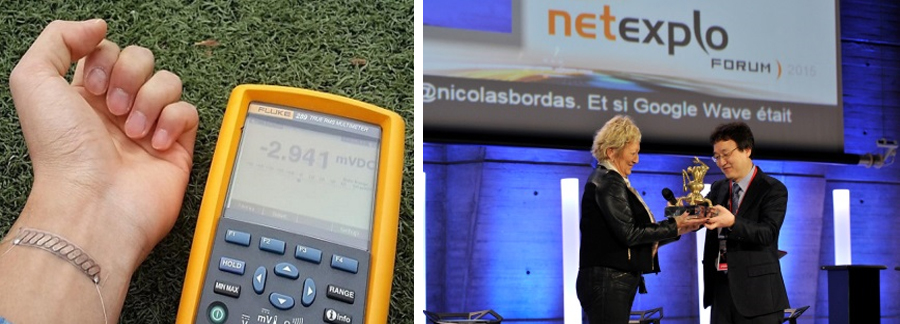
Charging on the Go: Online Electric Vehicle System
KAIST’s Online Electric Vehicle (OLEV) is a system that charges electric vehicles while stationary or driving, thus removing the need to stop for charges. Developed by Professor Dong-Ho Cho of the Electrical Engineering Department and his research team, OLEV receives power wirelessly through a new application called “Shaped Magnetic Field in Resonance technology (SMFIR).” Electrical cables buried underneath roads create magnetic fields, and a receiving device installed underneath the electric vehicle collects the fields and converts them into electricity. Time, a US weekly magazine, listed OLEV as one of the 50 Greatest Inventions of the Year 2010 in its November 22nd issue. Since 2012, several OLEV buses have been operating daily to provide citizens with transportation in cities such as Yeosu, Gumi, and Sejong in Korea. In April 2015, Professor Cho signed a memorandum of understanding with the city government of Medellín, the second largest city in Colombia, to provide two OLEV buses for inner-city transportation services. The research team also developed OLEV for a high capacity transit system including trams and high-speed trains, successfully showcasing 60 kHz of power transferred wirelessly to trams and trains in 2013 and 2014, respectively.
< Time (November 22, 2010 >.png)
< OLEV Campus Shuttle at KAIST >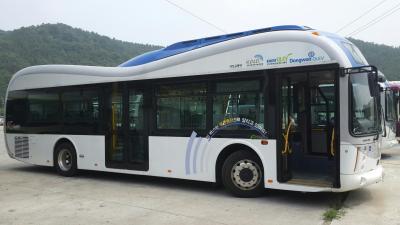
Pioneer in the Development of Functional Mesoporous Materials and Zeolites
On September 25, 2014, Thomson Reuters announced the “2014 Citation Laureates,” a list of candidates considered likely to win the Nobel Prize in the fields of physics, chemistry, physiology or medicine, and economics. Distinguished Professor Ryong Ryoo of the Department of Chemistry was named the 2014 Thomson Reuters Citation Laureates in Chemistry in recognition of his significant contribution to the advancement of designing functional mesoporous materials. He is the first Korean scientist to make the list. Professor Ryoo has pioneered the field of functional mesoporous materials and zeolites which are widely used as catalysts and sorbents. In 1999, he developed a nanocasting method, and with the technique, was able to synthesize ordered mesoporous carbon materials, for the first time in the world. Today, ordered mesoporous carbon materials have widespread applications in many areas such as adsorbents, catalysts and supports, gas-storage hosts, and electrode materials. Since 2006, using zeolite frameworks, Professor Ryoo has led the development of new methods to synthesize mesoporous materials whose molecules are designed to have a hierarchical structure of microspores and mesopores. He has published 255 research papers in renowned academic journals including Nature and Science. In December 2011, Science highlighted his research as one of the top ten breakthroughs in the year of 2011 in an article entitled “Directing Zeolite Structures into Hierarchically Nanoporous Architectures.” Professor Ryoo received numerous awards and honors including the World’s Top 100 Chemists over the Past 11 Years (2000-2010) by UNESCO and IUPAC (International Union of Pure and Applied Chemistry), the Breck Award by International Zeolite Association, and the Ho-Am prize in Science.
< Structures of Hierarchical Nanoporous Zeolites, Distinguished Professor Ryong Ryoo >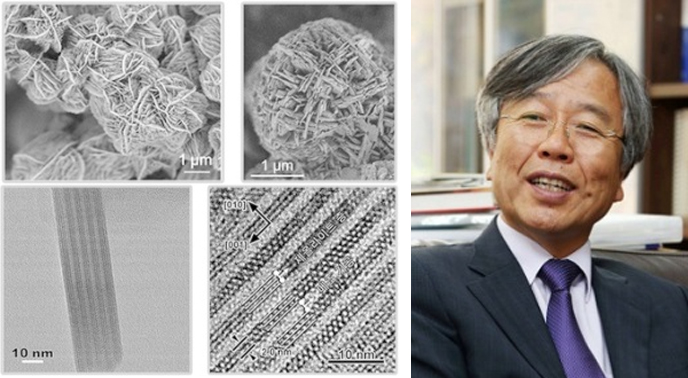
The Launch of Korea’s First Satellites into Space
Founded in 1989, the Satellite Technology Research Center (SaTReC) at KAIST has led the development of a series of Korean-made satellites over the past 26 years. The first satellite, the Korea Institute of Technology Satellite-1 (KITSAT-1), was launched on August 11, 1992, at the Guiana Space Center in Kourou, French Guiana. KITSAT-1 was designed in collaboration with a British university, the University of Surrey in Guildford. The success of KITSAT-1 sparked nation-wide interest in the development of space technology and led to the subsequent launches of 18 satellites and three carrier rockets such as KITSAT-2 and 3 (meteorological satellites); KSR-1, 2, and 3 (carrier rockets); KOREASAT-1, 2, 3, 5, and 6 (communication satellites); KOMPSAT-1, 2, 3, and 5 (multipurpose satellites); STSAT-1, 2C, and 3 (scientific satellites); and COMS-1 (navigation satellite). The latest scientific satellite, STSAT-3, and an earth observation satellite, KOMPSAT-3A, were launched in 2013 and 2015, respectively. The STSAT-2C, exclusively developed by SaTReC, was launched in January 2013 and transmitted data on the observation of space environments to the ground station located on KAIST’s campus for 14 months. The STSAT-2C was the first satellite developed solely with Korean technology. On June 30, 2009, the Korean government also established a spaceport in South Jeolla’s Goheung County, the Naro Space Center to launch satellites and spacecraft.
< Korea s First Satellite Developed by KAIST, Naro Space Center >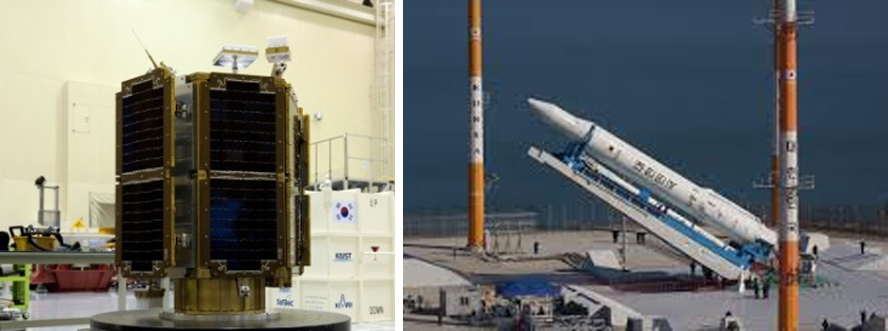
KAIST: Major Feeder for Startups in Korea
As seen in its core values of promoting creativity and a challenging spirit, KAIST has always encouraged startups and technology transfers led by university members including students and faculty. In the past four years from 2011 to 2014, students and faculty members have created 104 startups based on technology innovation and research outcomes, with an average of 26 new companies started per year. This is the highest number of university-led startups in Korea. As of 2013, KAIST graduates founded a total of 1,245 companies, generating approximately USD 1.5 billion sales and creating 34,000 jobs. KAIST has provided a variety of programs and facilities to build a startup-friendly campus culture and support student- and faculty-led entrepreneurship, for example, the End-Run Policy, Startup KAIST Studio, the Institute of Startup and Entrepreneurship, and the Startup Incubation Center. In particular, KAIST Idea Factory, a startup laboratory established last year, where students play around with ideas by conducting new experiments or building test products, created 3-D printers this year, producing 20 prototypes and filing four pending patents. Recently, KAIST has registered four proprietary standard patents with MPEG (Moving Picture Experts Group)-LA’s HEVC (High Efficiency Video Coding) Patent Portfolio License, which provides access to essential patent rights for the HEVC digital video coding standard. KAIST expects to acquire more than 50 proprietary standard patents within two years, generating close to UDS 1 million in income.
< Startup KAIST Studio, 3D Printers Developed by KAIST Students >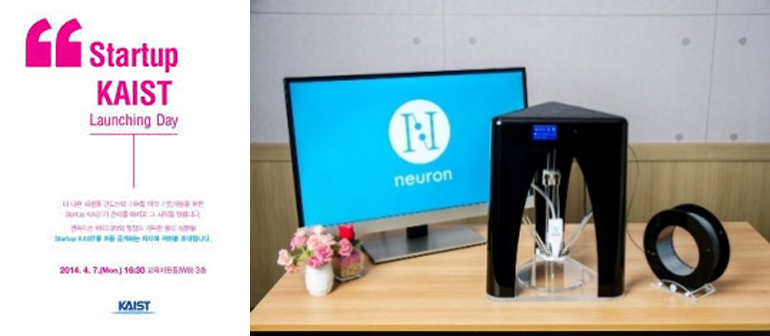
The Number of KAIST Doctoral Graduates Reaches Over 10,000
Since the establishment of KAIST forty-four years ago, more than ten thousand alumni have received their doctorates. The university’s 2015 Commencement ceremony took place on February 13, 2015, at the Sports Complex on campus, awarding Dr. Sun-Mi Cho of the Department of Biological Sciences the 10,000th doctoral degree. She also received her Bachelor’s and Master’s degrees from KAIST. In 1978, KAIST had only two doctoral graduates, but since 1987, there have been more than one hundred graduates each year, two hundred since 1994, and four hundred since 2000. In 2015 alone, 522 doctoral students graduated. One of the first doctoral graduates, Dr. Dong-Yol Yang (Class of 1978 in the Mechanical Engineering Department) became a professor in the same department of KAIST. In the early 1970s, many Koreans preferred to go abroad for Ph.D. degrees, but this changed when KAIST began to select candidates for master’s degrees in 1973, and doctoral degrees in 1975. Talented Korean students began to work in KAIST laboratories, and its graduates were known for their knowledge and skills. Now, KAIST receives many applications from talented foreign students as well. At the 2015 Commencement, KAIST conferred 522 Doctoral, 1,241 Master’s, and 915 Bachelor of Science degrees. Since its inception in 1971, KAIST has granted 10,403 doctoral degrees, 26,402 master’s degrees, and 51,412 bachelor’s degrees.
< Dr. Sun-Mi Cho, KAIST Commencement 2015 >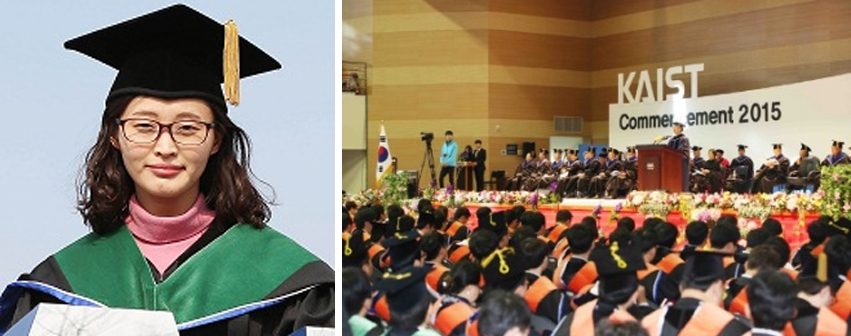
Fostering a New Learning Model: The Education 3.0 Program
KAIST undertook a bold initiative to improve its education system that would address more effectively the needs of today’s higher education to foster talents with creative and critical thinking skills. It introduced a new pedagogical model, the Education 3.0 program, to the campus in the spring of 2012, which was then an extremely rare movement taken by universities around the world. The Education 3.0 program incorporates flipped learning and smart classrooms. This means there are no formal lectures while in-class time is devoted to problem solving, exercises, projects, or discussions. The program provided students with greater opportunity to control their learning and interact more with professors and peers. Originally started with three general courses in physics, chemistry, and biology, the Education 3.0 is now offered in 50-60 courses per semester. In 2013 alone, approximately 2,000 KAIST students took the Education 3.0 courses. The university has also developed and implemented an e-Learning system to provide online courses, as well as participated in the Massive Open Online Course (MOOC). Partnering with Coursera since 2013, KAIST has offered three MOOCs in engineering and business management to the global community. Leading the efforts to create Korean MOOCs (K-MOOCs), KAIST agreed with other Korean universities in October 2015 to create online courses in basic subjects of physics, chemistry, mathematics, life science, mechanical engineering, and material science. K-MOOCs will be available in the summer of 2016.
< Smart Classroom for Edcation 3.0 Courses, Learner-centered Class >
Holistic Admissions for Undergraduates
Korean universities traditionally put an emphasis on students’ empirical data such as a GPA or the national College Scholastic Ability Test (CSAT) when reviewing applicants for the undergraduate admission. This practice, however, has posed serious challenges, most notably with CSAT’s requirement that the test takes place only once a year. It was simply impossible and unfair to assess students’ capability from the scores of a high-pressure, high-stakes standardized test. In 2009, KAIST changed its undergraduate admission process to consider the whole applicant’s profile, not just looking for students with good grades, but interesting and promising students who would contribute to the campus community in different and diverse ways. KAIST’s admissions officers have taken into account applicants’ interests, passions, special talents, and personality through their personal essays, recommendation letters, extracurricular activities, and intensive interviews. Prior to KAIST’s new policy, no other university in the nation had ever incorporated such a holistic approach to review student applications. Today, most Korean universities have adopted this admission policy. In addition, for the first time in Korea, KAIST offered all freshmen the option to defer the decision on majors, thereby allowing them to explore their interests more freely. Even after declaring majors as sophomores and higher classes, KAIST students can easily change their majors, and undergraduate students can actually create and lead their own research projects. As such, KAIST has continued to offer innovations to provide students with a quality education to foster their potential.
< Admission of Students Based on Their Whole Profile >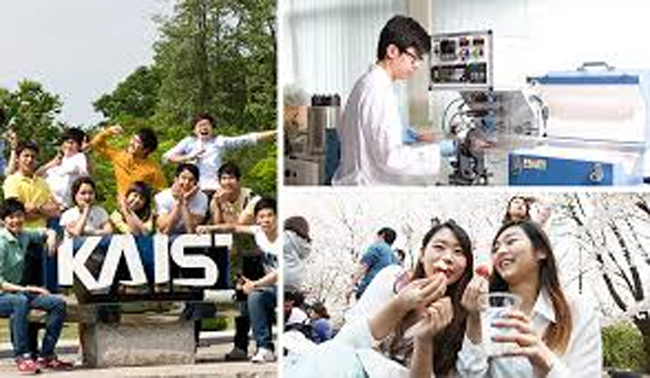
-
fund Hubo Professor Jun-Ho Oh Donates Startup Shares Worth 5 Billion KRW
Rainbow Robotics stock used to endow the development fund Emeritus Professor Jun-Ho Oh, who developed the 2015 DARPA Challenge winning humanoid robot DRC-Hubo, donated 5 billion KRW on October 25 during a ceremony held at the KAIST campus in Daejeon. Professor Oh donated his 20% share (400 shares) of his startup Rainbow Robotics, which was established in 2011. Rainbow Robotics was listed on the KOSDAQ this February. The 400 shares were converted to 200,000 shares with a value of approximate
2021-10-26 -
event Hubo Debuts as a News Anchor
HUBO, a humanoid robot developed by Professor Jun-Ho Oh’s team, made its debut as a co-anchor during the TJB prime time news 8 on May 14. “Un-contact" became the new normal after Covid-19 and many business solutions are being transformed using robotics. HUBO made two news reports on contactless services using robots in medical, manufacturing, and logistics industries. HUBO 2, the second generation of HUBO, appeared as a special anchor on the local broadcasting network’s spec
2020-05-14 -
event Hubo Completes New Mission at the Winter Olympic Torch Relay
KAIST-born humanoid robot, Hubo, completed its special new mission: carrying the Olympic torch. The Winter Olympics will be held in PyeongChang for two weeks beginning February 9. On December 11, the final leg of the torch relay in Daejeon for the PyeongChang Olympics 2018 took place inside KAIST. A city known for science and technology hosted special torch relay runners over three days. Hubo arrived at the campus with Dr. Dennis Hong, a professor from the University of California at Los
2017-12-12 -
event The Embassy Day Builds the Global Presence of KAIST
(Photo caption: Diplomats and KAIST faculty pose at the Embassy Day KAIST hosted on June 23.) KAIST is stepping up its initiative for building global competitiveness. The Embassy Day hosted on June 23 will be a stepping stone to diversify its channels for promoting the global presence of KAIST. KAIST invited the foreign diplomatic corps from Seoul to share their successful journey to emerge as the world-class university. The event featured KAIST’s research highlights, academic exp
2017-06-23 -
people 2017 KAIST Research Day Honors Professor Hoon Sohn
The 2017 KAIST Research Day recognized Professor Hoon Sohn of the Department of Civil and Environmental Engineering as Research Grand Prize Awardee in addition to the 10 most distinguished research achievements of the past year. The Research Grand Prize recognizes the professor whose comprehensive research performance evaluation indicator is the highest over the past five years. The indicator combines the factors of the number of research contracts, IPR, royalty income, as
2017-05-23